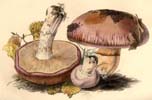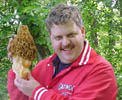Heinrich Anton de Bary (1831 - 1888)
Back to Author Index
Biography
Selected publications
Species
Genera
Biography
De Bary is the great pioneer in the biological aspects of mycology. Before him, mycology consisted mostly of people who named as many new species as they could, often after very informal observation. de Bary investigated the complex life cycle of the rusts and smuts, development and morphology of slime molds, and the complex relationships between parasite and host. He invented the term "symbiosis", and did much work explicating it in reference to the component organisms of lichens. Any mycologist doing work on ecological or developmental aspects of fungi owes the legitimacy of their field of research to de Bary. For his contributions, he is often called "the founder of modern mycology"
Some of the discoveries that he is most closely associated with were made by other people. For instance, it was the Tulasne brothers who discovered the complex life cycle of the rusts, which involved them over-wintering on a different host, where they produce a completely different-looking fruiting body. In the words of John Ramsbottom
That fungi can assume such curiously different forms was so unexpected and so startling, that, as the evidence accumulated, fact was not sufficient for some, and fancy reigned in its stead. What Tulasne was able to prove for comparatively large fungi, where it was possible to be certain of genetic connections, was assumed to occur in microscopic forms where reliance had to be placed on the imperfect methods of cultivation then available. Strange stories, or rather stories that now seem strange, had been told of developing yeast, and of moulds, before Tulasne's investigations, but from 1857 to 1969, there was an avalanche of phantasy which threatened to undermine the very foundations of mycology. Mushrooms and Toadstools p. 145
De Bary made many other important discoveries in his short life. He was the one who figured out that yeasts are fungi. He did important studies of the slime molds and was one of the main movers in getting bacteria separated from the fungi. In fact, he declared equally forcefully that the cyanobacteria were really bacteria, back when most other people thought they were a kind of alga. All this in only 57 years...
In the words of Constantine John Alexopoulos, C. W. Mims & Meredith Blackwell's (1996) Introductory Mycology, "His work contributed greatly to the demise of the idea of spontaneous generation and to the acceptance of Louis Pasteur's germ theory of disease, which was published in 1863."
Back to top
Selected Publications
Heinrich Anton de Bary (1853) De plantarum generatione sexuali (On the sexual reproduction of plants)
Heinrich Anton de Bary (1853) Untersuchungen über die Brandpilze und die durch sie verursachten Krankheiten der Pflanzen mit Rücksicht auf das Getreide und andere Nutzpflanzen (Researches on the Smut Fungi and the diseases that they cause in plants, with regards to grain (corn) and other commercial plants)
Heinrich Anton de Bary (1859) Die Mycetezoen. Ein Beitrag zur Kenntniss der niedersten Thiere (The Slime Molds. An introduction to understanding the lowest animals)First important book on Slime Molds. de Bary knew from the very beginning that they were big amoebas, not fungi.
Heinrich Anton de Bary & Mikhail S. Woronin (1863) Beitrag zur Kenntnis der Chytrideen (Contribution to the understanding of the Chytrids)
Heinrich Anton de Bary (1863) Über die Fruchtentwicklung der Ascomyceten (On the development of the fruiting bodies of the Ascomycetes)
Heinrich Anton de Bary (1864 - 1865) "Zur Kenntnis der Peronosporen" (Towards an understanding of the Peronosporaceae) in Abhandlung, hrsg. von der Senckenbergischen Naturforschenden Gesellschaft (Treatises, published by the Senckenberg Naturalists' Association) 5 pp. 367 - 372
Heinrich Anton de Bary (1864 - 1865) "Beiträge zur Morphologie und Physiologie der Pilze" (Introduction to the Morphology and Physiology of Mushrooms) in Abhandlung, hrsg. von der Senckenbergischen Naturforschenden Gesellschaft (Treatises, published by the Senckenberg Naturalists' Association) 5 pp. 137 - 232in four sections:
1. Development of Protomyces and Physoderma
2. Exoascus pruni and the pocket disease of plum trees
3. On the morphology of the Phalloids
4. Syzygites megalocarpus
Heinrich Anton de Bary (1864 - 1865) "Zur Kenntnis der Mucorinen" (Towards understanding the Mucorales) in Abhandlung, hrsg. von der Senckenbergischen Naturforschenden Gesellschaft (Treatises, published by the Senckenberg Naturalists' Association) 5 pp. 345 - 366
Heinrich Anton de Bary & Mikhail S. Woronin (1865) "Supplément à l'histoire des Chytridiacées" (Addendum to the natural history of the Chytrids) in Annales des Sciences Naturelles. Botanique (Annals of Natural History. Botanical series.) 3rd series, 5 pp. 239 - 269
Heinrich Anton de Bary (1866) "Über die Keimung einiger grossSporiger Flechten" (On the Sprouting of some large-spored Lichens) in Jahrbuch für wissenschaftliche Botanik (Yearbook for Scientific Botany)
Heinrich Anton de Bary (1866) "Neue Untersuchungen über die Uredineen, insbesondere die Entwicklung der Puccinia graminis und den Zusammenhang derselben mit Aecidium Berberidis" (New Researches into the Uredinales, in particular the development of Puccinia graminis and its connection with Aecidium berberidis) in Monatsberichte der Koniglichen Preussichen Akademie der Wissenschaften zu Berlin This is the paper that followed the life-cycle of P. graminis (a rust fungus that is an important pathogen of just about any Western grain you can think of) and showed that A. berberidis is just a life-stage of P. graminis.
According to Dörfelt, the volume was published in 1866, but bears the date 1865, so that's where you'll find it in the library.
Heinrich Anton de Bary (1866) Morphologie und Physiologie der Pilze, Flechten und Myxomyceten (Morphology and Physiologie of the Fungi, Lichens, and Slime Molds) 1st ed.This became a standard textbook, especially in its second edition, and in its English translation
Heinrich Anton de Bary (1867) "Neue Untersuchungen über die Uredineen" (New Researches on the Uredinales) in Monatsberichte der Koniglichen Preussichen Akademie der Wissenschaften zu Berlin Uredinales, the sequel. Apparently the first set of Researches was very popular.
Like its prequel, it actually bears the date (1866) of the year before it was actually published
Heinrich Anton de Bary (1869 - 1870) "Eurotium, Erysiphe, Cincinnobolus. Nebst Bemerkungen überdie Geschlechtsorgane der Ascomyceten" (Eurotium, Erysiphe, Cincinnobolus. With some remarks on the infective organs of the Ascomycetes) in Abhandlung, hrsg. von der Senckenbergischen Naturforschenden Gesellschaft (Treatises, published by the Senckenberg Naturalists' Association) 7:3 pp. 361 - 455
Heinrich Anton de Bary (1869) "Zur kenntnis insektentödtender Pilze" (Towards an understanding of the insect-killing fungi) in Botanische Zeitung (Botanical Magazine) 27 pp. 585 - 593
Heinrich Anton de Bary (1869) Die Erscheinung der SymbioseThis is the work for which he coined the term "symbiosis", originally given as a lecture for a convention of German naturalists. Actually, the concept of symbiosis was already known: de Bary quotes the parasitologist Van Beneden as using the term "mutualism" in a similar sense (so mutualism actually pre-dates symbiosis!). And parasitism is actually a major part of de Bary's concept: his favorite examples are tapeworms, the potato blight, and the fungal disease of silkworms.
Heinrich Anton de Bary (1874) "Protomyces microsporus und seine Verwandten" (Protomyces microsporus and its relatives) in Botanische Zeitung (Botanical Magazine) 32 pp. 81 - 92
Heinrich Anton de Bary (1876) "Researches into the nature of the potatofungus Phytophthora infestans" in Journal of Botany 14 pp. 105 - 126Is this a citational glitch, or is De Bary indulging in simultaneous publication?
Heinrich Anton de Bary (1876) "Researches into the nature of the potato-fungus, Phytophthora infestans" in Journal of the Royal Agricultural Society of England 2nd series, 12 pp. 239 - 269
Heinrich Anton de Bary (1881) "Untersuchungen über die Peronosporeen und Saprolegnieen und die Grundlagen eines natürlichen Systems der Pilze" (Researches on the Peronosporales and Saprolegniales, and the foundation of a natural classification system for the Fungi) in Abhandlung, hrsg. von der Senckenbergischen Naturforschenden Gesellschaft (Treatises, published by the Senckenberg Naturalists' Association) 12 pp. 225 - 370
Heinrich Anton de Bary (1881) "Zur Kenntnis der Peronosporeen" (Towards and Understanding of the Peronosporiales) in Botanische Zeitung (Botanical Magazine) 39 pp. 521 - 625
Heinrich Anton de Bary (1883) "Zu Pringsheims Beobachtungen über den Befruchtungsact der Gattungen Achlya und Saprolegnia" (On Pringsheim's observations of fertilization in the genera Achlya and Saprolegnia) in Botanische Zeitung (Botanical Magazine) 41 pp. 38 - 60
Heinrich Anton de Bary, Heinrich Georg Winter & Heinrich Simon Ludwig Friedrich Felix Rehm (1884) Deutschlands Kryptogamen-Flora oder Handbuch zur Bestimmung der kryptogamischen Gewächse Deutschlands, der Schweiz, der Lombardisch-Venetianischen Königsreichs und Istriens: Schizomyceten, Saccharomyceten, und Basidiomyceten (Germany's Cryptogamic Plants; or Handbook for determinig the cryptogamic plants of Germany, Switzerland, the kingdoms of Lombardy and Venice, and Istria Schizomycetes (Bacteria), Saccharomycetes, and Basidiomycetes) 2 vol. pp. 1 - 924
Heinrich Anton de Bary (1884) Vergleichende Morphologie und Biologie der Pilze, Mycetozoen und Bakterien (Comparative Morphology and Biology of the Fungi, Slime Molds, and Bacteria) 2nd ed.This is the second edition of the 1866 textbook. Times have changed; the lichens are out, the bacteria are in, and he uses a term for the slime molds that makes it clear that he doesn't consider them fungi. This edition also emphasizes the biology of the organisms it discusses. That may be the reason for the bacteria/lichen switch: nobody really knew much back then about the biological processes of lichens.
Another sign of the changing times: the Introduction tells us how happy it is that he no longer feels obliged to include the chapter refuting spontaneous generation (and thus he can use the room for more productive stuff).
In this book, he also says that the slime molds are really just big amoebas, and he supports the contemporary move to place them (the amoebas) outside the animal and vegetable kingdoms (the first time such a thing had been done). (p. 442-444) He also follows (helps create?) modern understanding when he says that the bacteria have no relationship whatsoever to the fungi, and that furthermore, the bacteria with chlorophyll (our "cyanobacteria") have no essential differences from those with no chlorophyll. (p. 474-475) On the other hand, he clearly considers fungi to be plants, and goes so far as to offer an extended (p.119-126) series of analogies between the alternation of generations in ferns and the alternation of generations in rusts, as "proof" that there is a close biological affinity between the two taxa. Thus, we get fungi as "plants" for another 70-80 years...
Heinrich Anton de Bary (1886) "Über einige Sclerotien und Sclerotienkrankheiten" (On some species of Sclerotia and the diseases they cause) in Botanische Zeitung (Botanical Magazine) 44 pp. 377 - 474
Heinrich Anton de Bary (1887) Comparative Morphology and Biology of the Fungi, Mycetozoa, and BacteriaThe English edition of his famous textbook.
Heinrich Anton de Bary, Heinrich Simon Ludwig Friedrich Felix Rehm & Heinrich Georg Winter (1887) Deutschlands Kryptogamen-Flora oder Handbuch zur Bestimmung der kryptogamischen Gewächse Deutschlands, der Schweiz, der Lombardisch-Venetianischen Königsreichs und Istriens: Ascomyceten: Gymnoasceen und Pyrenomyceten (Germany's Cryptogamic Plants; or Handbook for determinig the cryptogamic plants of Germany, Switzerland, the kingdoms of Lombardy and Venice, and Istria Ascomycetes: Gymnoascea and Pyrenomycetes) pp. 1 - 928plus 112 pages of index
Heinrich Anton de Bary (1888) "Species der Saprolegnieen" (Species of Saprolegnia) in Botanische Zeitung (Botanical Magazine) 46 pp. 597 - 653
Back to top
Species
Phytophthora infestans (Montagne) de Bary
Back to top
Genera
Aphanomyces de Bary
Aplanes de Bary
Echinostelium de Bary
Phytophthora de Bary
Piptocephalis de Bary
Pythiopsis de Bary
Back to top











